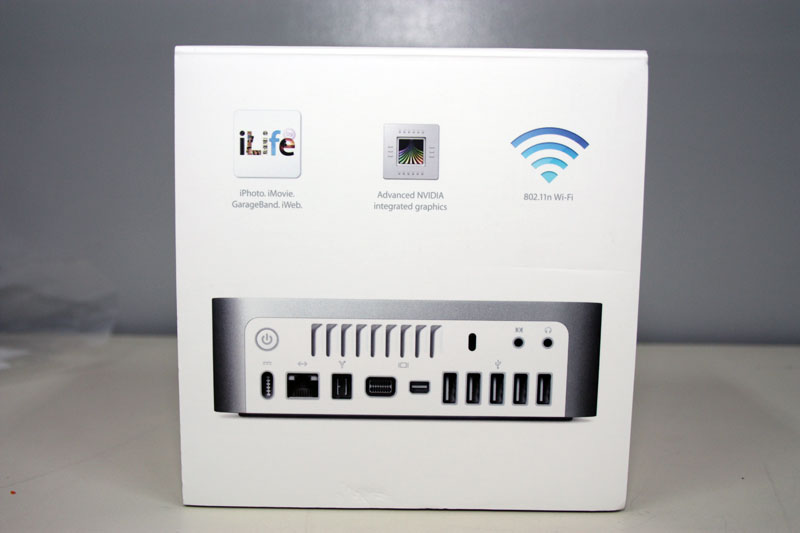Apple's new Mac mini is still easy to pry open with a putty knife and features some internal component rearrangement while the new iMac sports a slimmer, more refined pedestal and some other tweaks, as two sets of unboxing and comparison shots reveal.
Mac mini
Apple debuted the new mini with five times better graphics by utilizing the same NVIDIA GeForce 9400M integrated graphics used in the unibody MacBooks. Apple interim chief Tim Cook also called it "the world's most energy efficient desktop computer" and the "most affordable Mac" because it uses 13 watts of power when idle - or 10 times less power than a typical desktop PC.
Starting at $599, the Mac mini had gone without updates since late summer of 2007.
Macminicolo.net, which is responsible for both sets of photos, reports getting a call from its local Apple Store yesterday with an invitation to pick up one of the new machines. Wasting no time to check it out, a photo gallery shows the unboxing and gentle dismantling that soon followed.
The back of the 31 percent smaller retail box shows the same design, leaked by a tipster earlier this week, that recommends the preinstalled iLife suite, advanced graphics, and 802.11n wireless.

Open the box up, and you'll find the familiar "Designed by Apple in California" box, documentation and installation/restoration discs, the Mac mini itself, and an external power adapter with cord. Apple also packs in a mini-DVI to DVI adapter.
Macminicolo.net stacked the old mini on top of the new to highlight the differences in the subtly redesigned back panel. The power button and port, air vents, security slot, Ethernet jack, and the combined audio input and output minijacks are unchanged.
FireWire 400 is gone, replaced with FireWire 800, and the large footprint from the DVI connector has been filled with a mini-DVI connector, Mini DisplayPort, and a fifth USB 2.0 port to join the four previously present.
Upon opening the case, there are now three antennas on the top section that must be separated from the logic board before it can be fully opened. Macminicolo.net confirmed the new SATA drive, which it predicted several months ago, and with the optical drive, fan, and hard drive removed -- seen below -- it's clear that the RAM has changed orientation from perpendicular to parallel with the front edge.
Additional photos here.
iMac
The Las Vegas-based colocation company also bought and unboxed a brand-new, top-of-the-line iMac, which Apple says is more affordable and more powerful with twice the memory and storage as its predecessor.
Comparing side-by-side with an old iMac box, the packaging is essentially identical save for the updated image.
The revised port layout shows off the new Mini DisplayPort emerging standard and an extra USB at the expense of FireWire 400 and DVI. FireWire 800 is right between the four USB connectors and the Ethernet jack.
Macminicolo.net uncovered an interesting design refinement that Apple hasn't been touting: a thinner, tapered stand that gives off a more elegant vibe than the larger and thicker stand it replaces. The difference can be clearly seen in this image, comparing the brand-new iMac on the left with its predecessor on the right.
Finally, this new iMac's display is configured by default to show colors in a little cooler temperature. Whether this is true of all the new models isn't yet known, given the early adoption, but it is possible to re-calibrate the display to your liking. Oddly, this change arrives in contrast to a change Apple made during the transition from the original iPhone to the iPhone 3G, which can not be user-calibrated.
The iPhone 3G features a yellow-tint compared to the original iPhone's blue tint, which Apple said was deliberate in order to generate more accurate colors, deeper blacks, and a crisper image.
Below is the new iMac, again on the left, compared with an earlier model's display.
Customers upgrading to a new iMac or who simply want a different color profile can look no further than the Color tab in Mac OS X's Displays system preference pane.
Additional photos here.
The above photos show Macminicolo's server room with roughly 400 Mac minis in operation | Photo: macminicolo, AppleInsider.
Macminicolo.net hosts hundreds of Mac minis in its data centers for customers in 26 different countries who use the low-cost, versatile machines as servers (see AppleInsider's in-depth profile of the company, which explains the various corporate uses for the mini). The colocation firm also recently added Time Capsule hosting to their product offerings.


